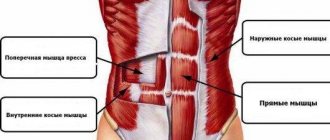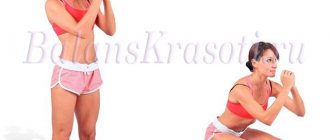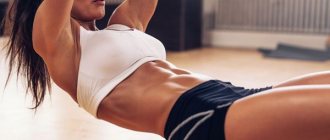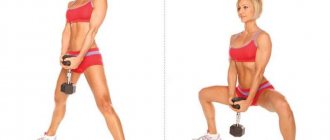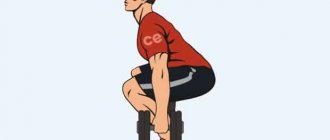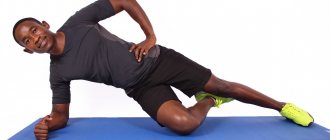Why do 100 squats every day?
It is believed that in order to grow muscles, it is necessary to perform strength exercises with heavy equipment. But most lovers of a healthy lifestyle do not need bulky muscles. Their goal is a toned, slender body with minimal fat. For such athletes, we recommend doing 100 squats a day. For beginners, the exercise should be performed with your own body weight.
Let's consider the positive effect of such training:
- Fat burning . At first glance, it seems that 100 repetitions per day is not enough for weight loss. In fact, after 50–60 squats, the athlete experiences the same load as a twenty-minute jog at an easy pace, while burning 120–150 kcal.
- Getting rid of cellulite . Flabby buttocks and thighs are one of the main women's problems. A set of squats performed every day improves blood supply to the subcutaneous layer, which helps cope with cellulite.
- Correction of the shape of the hips and buttocks . Of course, you won’t be able to build muscle in your lower body. But through regular exercise, the athlete increases blood circulation, which helps maintain toned legs and buttocks.
- Posture correction . The technique of classic squats involves maintaining a flat back with a slight arch in the lower back. Thanks to this, the muscles and tissues around the spine are strengthened. As a result, the stoop disappears and a beautiful gait appears.
- Increased endurance . During daily training, not only muscles are strengthened, but also ligaments and tendons. This allows for more productive cardio training, which improves weight loss results.
All positive aspects are noticeable only with regular exercise. You can't skip workouts. Even if you feel tired or sore in your muscles, you still need to do 100 squats. This is how the athlete maintains muscle tone, maintains metabolic processes at a high level and forms the habit of daily physical activity.
Training with your own body weight does not increase strength, but many girls have noticed that after 15-17 days of regular squats they feel lighter and can do more repetitions. In this case, it is recommended to add weights to your training plan. Light dumbbells from 2 to 5 kg or a special weight belt are suitable for this.
Sample programs
If you have a personal trainer, a squat program for the next 30 days is her job. She knows your initial data and individual characteristics, which she will definitely take into account. But not everyone has this opportunity. And if you try to do it yourself, there is always a risk of incorrectly distributing the load and ruining everything. Therefore, it is much more convenient to use ready-made developments.
The most convenient option is a table. It can be printed and clearly shows progress. For added incentive, you can hang it on the wall and use a colored marker to mark the path you have already left behind. Believe me, such a minor technique greatly stimulates you to continue training when it seems that you have neither the strength nor the time for it.
For girls
In the squat program for girls, the number of sets and repetitions is much less than for men. This is determined not only by differences in strength indicators. The main thing is that women need to pump up their gluteal muscles, and it is for this purpose that such parameters have been included in the training scheme. Type of exercises: basic.
Option 1. Lightweight. You describe the approaches yourself. The maximum number of repetitions at the end of the month is 145.
Option 2. More complex. The approaches are outlined. The maximum number of repetitions at the end of the month is 240.
For men
In the program for men, the number of approaches and repetitions is much greater. After all, the main thing here is to pump up your quadriceps and build muscle mass. Therefore, it is strongly recommended to pick up a barbell or dumbbells (for beginners) to increase strength. This will enhance the effectiveness of your training and give amazing results - not only sculpted hips, but also developed biceps and chest.
Men can determine the number of approaches themselves, depending on their physical fitness. The main thing is that the end result is the number of repetitions indicated in the table.
Squat programs like these are the result of careful development by specialists. The number of approaches and repetitions, the training scheme - all this is written here for a reason. People who are well versed in the anatomy of the human body calculated which load is optimal for men and which for women. There is no need to be afraid of the big numbers at the end of these tables. As they say, the eyes are afraid, but the legs (in our case) do. If at some stage you failed, did not complete the required number of times, let this become an incentive for further improvement, and not disappointment.
What kind of squats should I do?
Beginning athletes are faced with the problem of selecting exercises from a variety of squat options. We recommend starting with the classic ones - feet shoulder-width apart, back straight, pelvis lowered to a right angle at the knees or slightly lower. This technique allows you to use the quadriceps and buttocks - muscle groups responsible for the formation of beautiful legs.
To fully work out your lower body, you should combine different types of squats. For example, girls very often have the problem of sagging inner thighs. An effective exercise in this case would be a plie squat - the feet stand very wide, the toes are turned outward, the pelvis is lowered to a right angle at the knees. The element allows you to work the adductor muscles of the thigh.
There are also squats for the buttocks - curtsy. Briefly about the technique: the athlete takes a wide step back and places his toe on the floor; the foot of the abducted limb should be behind the line of the supporting leg; From this position, smooth squats are performed. The element specifically loads the gluteal muscles. To enhance the effect, we recommend using light dumbbells or weights.
Is it possible to lose weight with squats?
It is quite possible to reduce body weight by burning body fat with the help of squats. This is an energy-intensive exercise that uses all muscle groups and helps burn a lot of calories.
Many experts recommend doing classic squats for weight loss because this exercise works the entire lower body - hips, buttocks, quadriceps and hamstrings, as well as the core and lower back muscles. As a result, you get not only toned buttocks and legs, but also a flat stomach. Plus, you'll get stronger, reduce your risk of injury, and have a great base for other workout programs.
Before jumping directly into the 30-day fat-burning squat program itself, familiarize yourself with the specifics of the technique.
Are you new to sports and don’t know how to do squats correctly in order to lose weight? Follow this little instruction:
- Starting position: standing straight, feet hip-width apart, toes pointing forward, chin raised, abdominal muscles tense.
- Keep your arms in front of you or at your sides, but never put your hands on your legs.
- Bend your knees and lower yourself until parallel to the floor. Imagine that you are sitting on an invisible chair. If you can, go lower. As long as you're not in pain (or losing your balance), you'll be fine. If you're not sure you're squatting low enough, place a box behind you that's just below your knees. Each time you touch the box with your butt counts as a rep completed.
- Stand up and repeat again.
Once you've got the technique down, it's time to figure out how to lose weight with squats.
Squat technique and mistakes
Beginners believe that exercises without power equipment are undemanding in terms of quality of execution. This is wrong. If you do not pay attention to mistakes, you can negate the benefits of the element and harm the body.
Let's look at the technique of classic squats:
- Let's get straight.
- We spread our feet shoulder-width apart, with our toes slightly turned to the sides.
- Inhale and smoothly lower the pelvis to a right angle at the knee joints.
- At the same time, bend your arms and bring your palms together at chest level.
- Exhale and rise to the starting position.
At first glance, the technique is simple. But you should take into account the nuances that affect the effectiveness of the exercise:
- Keep your head straight. When the chin drops, an involuntary rounding of the upper back occurs.
- We don’t “throw” our body down, we sit down smoothly. Excluding the negative phase of the squat reduces its overall effectiveness.
- Don't lean forward too much. The basis of the movement should be abduction of the pelvic region back and bending of the legs.
- Keep the center of gravity in the middle of the feet. When you shift onto your toes, the dangerous load on your knees increases.
When performing squats, maintain a bend in your lower back. Back position is very important. If you “round” the spine, the effect of stretching the gluteal muscles is lost, and the load shifts to the front of the thigh. Watch your back position throughout the entire approach.
Monthly training plan for girls
The 30-day squat program is designed to provide a comprehensive lower body workout. The plan includes 3 exercises that allow you to effectively train the muscles of your thighs and buttocks. Due to the fact that the complex simultaneously engages large muscles, calorie consumption increases, and this has a positive effect on weight loss.
Squat Chart:
| Day | Classic squats | Plie | Curtsy | Total |
| 1 | 14 | 15 | 15 | 44 |
| 2 | 16 | 16 | 16 | 48 |
| 3 | 18 | 17 | 17 | 52 |
| 4 | 20 | 18 | 18 | 56 |
| 5 | 22 | 19 | 19 | 60 |
| 6 | 24 | 20 | 20 | 64 |
| 7 | 26 | 21 | 21 | 68 |
| 8 | 28 | 22 | 22 | 72 |
| 9 | 30 | 23 | 23 | 76 |
| 10 | 32 | 24 | 24 | 80 |
| 11 | 34 | 25 | 25 | 84 |
| 12 | 36 | 26 | 26 | 88 |
| 13 | 38 | 27 | 27 | 92 |
| 14 | 40 | 28 | 28 | 96 |
| 15 | 42 | 29 | 29 | 100 |
| 16 | 44 | 30 | 30 | 104 |
| 17 | 46 | 31 | 31 | 108 |
| 18 | 48 | 32 | 32 | 112 |
| 19 | 50 | 33 | 33 | 116 |
| 20 | 52 | 34 | 34 | 120 |
| 21 | 54 | 35 | 35 | 124 |
| 22 | 56 | 36 | 36 | 128 |
| 23 | 58 | 37 | 37 | 132 |
| 24 | 60 | 38 | 38 | 136 |
| 25 | 62 | 39 | 39 | 140 |
| 26 | 64 | 40 | 40 | 144 |
| 27 | 66 | 41 | 41 | 148 |
| 28 | 68 | 42 | 42 | 152 |
| 29 | 70 | 43 | 43 | 156 |
| 30 | 72 | 44 | 44 | 160 |
Rest between exercises is 45–60 seconds. Try to keep your breaks short. Do your workout at an average pace.
Make sure that the lowering of the body is equal in time to the rising. The plan is suitable for those who find the “100 reps per day” scheme difficult.
Useful tips
You can immediately print out the data below the table with squat programs for 30 days and start training. But after that, don’t be surprised by the lack of results. In any business there is a theory that must first be studied before starting practice. If you do not take into account some nuances, training may be useless. Therefore, be sure to listen to the recommendations of experienced gurus in this matter.
- In the first month of training, the program should be lightweight: a minimum of sets with a minimum of repetitions.
- Start with shallow squats, where the bottom point is determined by your thighs parallel to the floor.
- You don’t need to immediately pick up dumbbells or a barbell. In the first month, squats should be without weight (at least for girls, for sure).
- Learn the correct technique.
- The general goal of such programs for both men and girls is weight loss and figure correction. But for the former, we also add to this the increase in muscle mass and improvement in strength indicators. And for the latter - strengthening the buttocks and eliminating cellulite.
- Such activities are contraindicated in the presence of injuries and fractures, joint diseases and problems with the musculoskeletal system, back and knee pain, pregnancy and lack of flexibility.
- Severe pain after training is a signal to stop or reconsider the training program (reduce the number of repetitions, for example). Perhaps you are violating your execution technique.
- Do not start training without warming up, otherwise injuries will not be avoided.
- Watch your breathing, which is very important in squats: inhale - squat, exhale - rise.
And one more very important point. If you were unable to do the required number of repetitions, this does not mean that you need to despair and start training from the very beginning. Keep practicing and do as many squats as you can, and let the numbers in the table serve as your guide. If you weren’t able to reach the desired level in the first 30 days, you will be able to next month. You don't plan to stop training, do you?
Program “200 squats”
It is difficult for beginner athletes to train without recovery breaks. With this regimen, they experience constant fatigue and muscle pain. Daily physical activity causes lethargy, low mood and decreased motivation are often observed.
The listed symptoms indicate the development of overtraining. This condition causes progress in sports to stop.
To avoid the adverse consequences of daily training, it is necessary to structure the program in such a way that a “window” appears between classes - at least 24 hours. During this period, the body will restore damaged muscle fibers and burn subcutaneous fat.
Below is a plan that is designed for 3 workouts per week. In a month, the athlete will be able to perform 200 squats per session.
Week #1
| Day | Set 1 | Set 2 | Set 3 | Set 4 | Set 5 | Total |
| Monday | 13 | 6 | 9 | 9 | 13 | 50 |
| Wednesday | 13 | 16 | 13 | 16 | 16 | 74 |
| Friday | 15 | 20 | 13 | 13 | 18 | 79 |
Week #2
| Day | Set 1 | Set 2 | Set 3 | Set 4 | Set 5 | Total |
| Monday | 19 | 19 | 13 | 13 | 20 | 84 |
| Wednesday | 19 | 19 | 16 | 16 | 23 | 93 |
| Friday | 22 | 23 | 19 | 19 | 27 | 110 |
Week #3
| Day | Set 1 | Set 2 | Set 3 | Set 4 | Set 5 | Total |
| Monday | 24 | 24 | 24 | 24 | 24 | 120 |
| Wednesday | 27 | 34 | 21 | 21 | 34 | 137 |
| Friday | 30 | 30 | 30 | 30 | 30 | 150 |
Week #4
| Day | Set 1 | Set 2 | Set 3 | Set 4 | Set 5 | Total |
| Monday | 29 | 34 | 29 | 38 | 40 | 170 |
| Wednesday | 34 | 34 | 32 | 40 | 45 | 185 |
| Friday | 40 | 40 | 40 | 40 | 40 | 200 |
Pauses between approaches are 50–60 seconds. By the fourth week, breaks should be gradually reduced to a minimum. The main exercise is classic squats with your own weight.
After a month of regular exercise, we recommend adding weights - dumbbells from 2 to 4 kg - and repeating the program.
Men's training plan
One of the goals that men set for themselves when playing sports is to improve their strength. This can be achieved without the use of heavy barbells and dumbbells. We offer a program designed to increase leg endurance and strength.
The squat scheme is designed for a month, but classes are not daily. You need to rest for two days between workouts. This period is used for muscle recovery.
- Workout 1 - “squats” in a shoulder stand (3x50). The exercise is designed to prepare the beginner's muscles for stress. Lie on your back on the floor. Pull your knees sharply towards your chest, then immediately push your legs vertically into a “birch tree” pose. Support your back with your hands. Inhale and lower your knees to your forehead. As you exhale, straighten your legs. Move evenly, without sudden jolts.
- Workout 2 - jackknife exercise (3x40). Stand half a meter from the chair (object height 50–60 cm). Without bending your legs, bend over and place your palms on the seat. A right angle should form between the hips and the body. Place your feet shoulder-width apart. Partially transfer your body weight to your arms. As you inhale, squat down to the end, as you exhale, rise up. When moving, do not lift your palms from the chair.
- Workout 3 - Supported Squats (3x30). The exercise is similar to a jackknife, but due to the high support, the body weight remains almost entirely on the legs. Choose a stable piece of furniture 100–110 cm high. Stand facing it and place your hands on the surface. As you inhale, squat down deeply, and as you exhale, rise up. Avoid transferring the center of gravity to your toes or heels, push off with the entire surface of your feet.
- Workout 4 - partial squats (2x50). Stand tall, cross your forearms, and press your palms toward your opposite delts. Place your feet shoulder-width apart. Keeping your back straight, inhale and lower yourself until your knees form a right angle. Exhaling, slowly rise up. When moving, avoid “rounding” the spine. Don't lower your chin, look ahead.
- Workout 5 – full squats (2x30). Straighten your chest, spread your feet shoulder-width apart. Turn your toes slightly to the sides. With a deep breath, lower yourself all the way down into the squat. At the same time, straighten your arms in front of you. Exhaling, slowly rise to a vertical position. To understand the technique correctly, imagine sitting on a chair. That is, you don’t need to lean forward too much, just move your pelvis back and bend your legs.
- Workout 6 - narrow squats (2x30). This exercise allows you to shift the focus to working your quadriceps. Standing straight, bring your heels together. Spread your socks slightly apart. Stretch your arms forward. Inhale and slowly lower yourself into a deep squat. Exhaling, straighten your legs and return to the starting position. When doing this, make sure your back doesn’t “round.”
- Workout 7 - squats at different heights (2x20). The exercise allows you to individually load your legs with high quality. Stand half a meter from the ball (football, volleyball, basketball). Raise one leg and press your heel into the apparatus. Extend your arms in front of you. As you inhale, gently squat down, slightly rolling the ball forward, and as you exhale, rise up. Do 20 reps, then switch sides.
- Workout 8 - partial squats on one leg (2x20). Stand up straight, stretch your arms forward. Raise one leg in front of you so that its heel is 50–60 cm from the floor. Keeping your limb suspended, inhale and squat down on your supporting leg to a right angle at the knee. Exhale and rise up. After 20 repetitions, switch sides.
- Workout 9 - squats on one leg with emphasis on the ball (2x20). Place a ball next to your right foot. Extend your left arm and lift your left leg in front of you 50–60 cm from the floor. Lower your right arm freely along your body. Inhale and squat down completely. At the bottom point, press your palm against the ball. Exhale, push off the apparatus and rise up. Do 20 reps and switch sides.
- Workout 10 - single leg squats (2x50). If you have faithfully completed the previous 9 lessons, then you should not have any problems with this exercise. Stand up and lift one leg in front of you. Stretch your arms forward. As you inhale, squat down completely, and as you exhale, rise up. When moving, try not to bend the raised limb. Do 50 reps and switch sides.
Do all exercises at a slow pace. Rest between sets - depending on how you feel.
The training plan should be carried out in a strictly defined order. This is necessary to gradually lead the athlete to the tenth, most difficult strength training. If you change the order of exercises, the effect of the program will decrease.
Squats in bodybuilding
In bodybuilding, the maximum weight of the barbell is not so important. The time the muscle is under force load has a much greater impact on the result, which leads to subsequent hypertrophy of the fibers.
Technique
Straighten your shoulder girdle, bend your lumbar region, keep your head level. Maintain this back position until the end of the approach:
- Grab the bar with a comfortable grip and step under the bar. Then straighten up and press the top of your shoulder blades against the barbell.
- After removing the load from the racks, step back.
- Place your feet at shoulder level or slightly wider, and point your toes out to the sides (45°).
- Inhaling air, smoothly move your pelvis back and at the same time bend your knee joints.
- Lower yourself until a right angle is formed between your shin and thigh, then exhale and return to the vertical position.
Technique Tips:
- Do not “fall” forward with your body. Otherwise, you risk hurting your knees or falling.
- Don't bring your hips inward. Such an error can lead to damage to the ligaments of the knee joints.
- Monitor both phases of the exercise. A smooth squat and an equally smooth rise.
- Keep your center of gravity in the middle. If you shift your body weight forward onto your toes, there is a risk of injury to your knee joints.
Reasons for poor squat performance
Typically this is:
- Incorrect execution technique, shifting the payload from the lower body to the back muscles.
- Overexertion of the legs in beginners, resulting from a combination of strength and aerobic types of training.
- The weight of the barbell is too light, which cannot create the necessary load for the muscles of the lower body.
Ways to improve your squat performance
Recommendations:
- Use proper technique. Have an experienced athlete watch your squats and note any mistakes.
- Add a “back room” to the program. For example, do power lunges, leg extensions, or farmer's walks.
- Select the correct barbell weight. At the end of each set you should feel failure set in.
- Use sports nutrition. Creatine, protein, vitamins will help build muscle size and strength.
- Use weightlifting accessories - belts and bandages. This will allow you to increase the weight of the barbell in squats.
- Perform 3-4 sets of 8-12 repetitions. This amount of training is considered optimal for enlarging legs.
- Try different variations of squats: front squats, Smith machine, narrow/wide leg squats, Hackenschmidt squats, etc.
- Increase the load with each workout. This will not allow the leg muscles to adapt and will contribute to their constant growth.
- Lighten the weight and try doing full-range squats. That is, do not lower your pelvis below your knees, and at the top point do not straighten your legs completely. At the same time, increase the number of repetitions to 25–30 per set.
Interesting fact. Six-time Mr. Olympia Dorian Yates said he was disappointed with squats as a mass-gaining exercise. The famous athlete completely abandoned this basic exercise and replaced it with a leg press in the simulator.
He explained this by saying that when certain weight loads are reached in squats, the risk of injuring the knees or spine increases critically. Therefore, for athletes training with weights over 200 kg, Yates recommends moving to the platform press.
Note that this advice applies only to experienced bodybuilders. For beginners, squats remain the best exercise for developing muscle mass throughout the body.
About the benefits of comprehensive training
Women who play sports want to lose weight and gain a slim figure. Men strive to become stronger, more resilient and more muscular.
Whatever goal the athlete pursues, he can achieve a positive effect only if he trains comprehensively. This means that in one session you need to perform from 5 to 8 exercises, preferably for different muscle groups.
This fact is explained by the fact that when several large muscles are involved, energy expenditure increases and the release of growth hormones increases. This helps women quickly get rid of hated subcutaneous fat, while men increase strength and build muscle. Therefore, effective training programs include not single elements, but sets of exercises.
